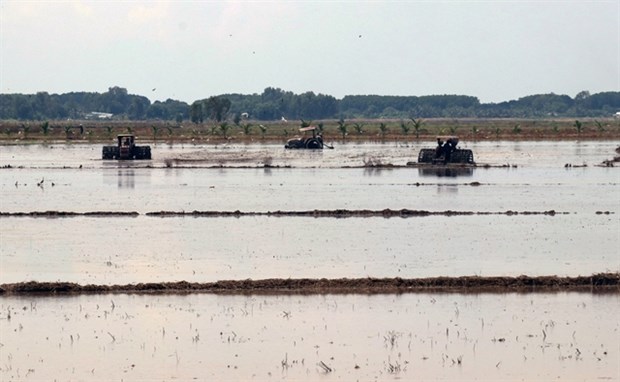New farming models increase incomes in Kien Giang
The income per capita of rural residents in Kien Giang province, the country’s largest rice producer, has reached 46.2 million VND (1,990 USD) a year, up 1.5 times against 2015, mostly due to the use of new farming models and agricultural restructuring.
 Farmers in Kien Giang province’s Hon Dat district prepare soil for sowing the 2019–2020 winter–spring rice crop (Photo: VNA)
Farmers in Kien Giang province’s Hon Dat district prepare soil for sowing the 2019–2020 winter–spring rice crop (Photo: VNA)Kien Giang (VNS/VNA) - The income per capita of rural residents in Kien Giang province, the country’s largest rice producer, has reached 46.2 million VND (1,990 USD) a year, up 1.5 times against 2015, mostly due to the use of new farming models and agricultural restructuring.
The figure is higher than the Mekong Delta’s income per capita in rural areas (36.7 million VND) and the country’s income per capita in rural areas (35.8 million VND), according to the provincial Department of Agriculture and Rural Development.
Under the national programme on new-style rural areas, the province has seen good results in recent years.
Do Minh Nhut, deputy director of the department, said the province had strongly encouraged farmers to use new seed varieties and advanced techniques as well as farming models that adapt to climate change.
More farmers are also applying Vietnamese and global good agricultural practices (VietGAP and GlobalGAP) standards.
Many large-scale rice fields in the province plant high-yield and quality rice varieties for export, while environmentally friendly concentrated shrimp areas use intensive farming methods.
Hoang Trung Kien, director of the province’s Agriculture Extension Centre, said that the number of large-scale rice fields this year increased by 44 percent against last year. The 213 large-scale fields cover 75,000ha, of which 71,000ha have been guaranteed outlets for their products.
Farmers have also turned many inefficient rice fields to rice-shrimp fields that grow shrimp in the dry season and rice in the rainy season.
These rice-shrimp fields expanded from 77,866ha in 2015 to 83,458ha last year, the largest area in the delta. An additional 20,000ha of rice-shrimp fields will be implemented after 2020, according to the department.
Aquaculture in coastal areas has developed rapidly with many farmed aquatic species such as black tiger shrimp, white-legged shrimp, river giant prawns, bivalve mollusks, and brackish water and freshwater fish.
Nhut said that irrigation systems had controlled flooding and saltwater intrusion, and had met the demand for breeding shrimp under industrial and semi-industrial farming models.
The province expects to harvest 256,000 tonnes of farmed aquatic species this year, including 78,000 tonnes of shrimp, according to the department. Rice and shrimp are the province’s two key products.
Effective models
The province has encouraged farmers to use semi-intensive and intensive shrimp farming, breed marine fish in floating cages, rotate shrimp and rice on the same field, and grow organic pepper.
Many farmers in Kien Luong district’s Hoa Dien commune are rotating the breeding of shrimp and crab and rice cultivation on the same field, earning high incomes.
Under this model, farmers plant rice in September, harvest rice in December, and then pump water into the rice field to breed shrimp and crabs.
Nguyen Phuoc Du, who was the first farmer to use the model on his 6ha rice field in Hoa Dien, has earned a profit of 250-300 million VND (10,800-12,900 USD) a year.
“Shrimp breeding under this model does not need much medicine or chemicals, which cuts production costs,” he said.
Having disease-free shrimp and crab fry for breeding is also very important, according to Du.
The commune has a cooperative with 15 members who are using a rice-crab rotation model on a total area of 50ha.
Giang Van Thom, Chairman of the Hoa Dien Commune Farmers Association, said the association would work with the commune's People’s Committee to establish more cooperatives to improve incomes.
Phu Van Khen, a farmer in Phu Quoc district’s Bai Thom commune earns a profit of 400 million VND (17,200 USD) a year from his mixed-farming model in which he grows forestry trees and fruit trees.
Besides breeding deer and wild boar, and raising fish in three ponds, he offers food and room services for tourists. He also employs 10 workers who are paid 5-6 million VND (215-260 USD) a month.
In the last two years, Khen donated 2,000sq.m of land and more than 100 million VND (4,300 USD) to build a rural road and support poor locals.
The new-style rural area programme in the province has received support and contributions from local residents and companies to build infrastructure like roads and irrigation works.
Mai An Nhin, Vice Chairman of the provincial People’s Committee, said: “The new-style rural area programme … has improved production efficiency, labour value of rural residents, and farmers' incomes.”
The province expects to mobilise about 29.2 trillion VND (1.26 billion USD) from various sources, including central and local budgets and donations from locals and companies, for the new-style rural area programme in the 2010-2020 period.
The province has more than 728,400ha of rice fields that produce about 4.2 million tonnes of paddy each year./.













